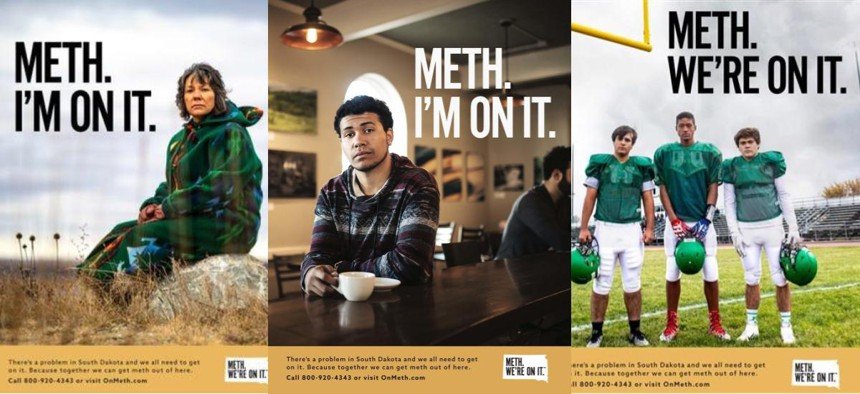
South Dakota’s Controversial Meth Campaign: Can Poor Messaging Make a Difference?
Posted in :
South Dakota’s “Meth, We’re On It” campaign, launched under Governor Kristi Noem, intended to combat meth addiction but sparked backlash for its provocative messaging. While the campaign raised awareness, it also highlighted the dangers of poor public health communication and the need for empathy and clarity in addiction advocacy.
The controversial anti-meth campaign launched by South Dakota’s Governor Kristi Noem. It critically examines the messaging strategy, public reactions, and the broader implications for public health initiatives.
Recently, a campaign in South Dakota has sparked outrage and discussion—not for its intention, but for its provocative messaging. As someone who has followed political campaigns closely, I was startled to learn that the slogan “meth, we’re on it” could be a genuine endeavor to tackle addiction. Is this an example of misguided sincerity or merely a ridiculous PR stunt? Let’s unravel the story behind Christine Gnome’s bold—and questionable—attempt to raise awareness around methamphetamine addiction.
Background on the Anti-Meth Campaign
In 2019, South Dakota launched a significant initiative aimed at combating the rising tide of methamphetamine addiction. This campaign, spearheaded by Governor Kristi Noem, came with a budget of $500,000. The primary goal was clear: to raise awareness about the dangers of meth use and to encourage community involvement in addressing this pressing issue.
Campaign Goals and Budget
The anti-meth campaign was designed to tackle a serious problem. Methamphetamine addiction had been on the rise in South Dakota, affecting countless lives and families. The campaign aimed to:
- Raise awareness about the dangers of meth use.
- Encourage community participation in prevention efforts.
- Provide resources for those struggling with addiction.
With a budget of $500,000, the campaign sought to make a significant impact. But was this amount sufficient? Critics argue that the funds could have been better allocated. They question whether the campaign’s approach truly addressed the complexities of addiction.
Key Accomplishments and Events
The campaign kicked off with a series of provocative advertisements. One of the most notable features was the slogan,
‘We need everyone to get on it’
. This phrase aimed to rally the community around the cause. However, it also sparked controversy. Some viewed it as trivializing a serious issue. The ads featured individuals candidly stating,
‘I’m on meth’
, which was intended to shock viewers into awareness. But did it succeed?
While the campaign did generate buzz, it also faced backlash. Social media reactions ranged from disbelief to amusement. Many questioned the effectiveness of such a bold approach. Critics pointed out that the ads might have missed the mark in conveying the gravity of the situation.
Critique of Messaging Strategies
One of the most significant critiques of the campaign revolves around its messaging strategies. The slogan and the advertisements were seen as provocative but not necessarily effective. Critics argue that the campaign’s approach lacked depth. It seemed to focus more on shock value than on meaningful dialogue about addiction.
Moreover, the decision to trademark the slogan ‘meth we’re on it’ raised eyebrows. Was it appropriate to commercialize a serious public health issue? This move led to further skepticism about the campaign’s intentions. Many felt that it trivialized the struggles faced by those battling addiction.
Governor Gnome defended the campaign, stating that it was primarily aimed at raising awareness. However, her insistence on sticking to the original messaging, despite the backlash, raised questions about her leadership. Was she truly listening to the concerns of the community? Or was she doubling down on a flawed strategy?
The campaign’s execution revealed a significant communication gap within Gnome’s administration. The provocative nature of the ads did not resonate with everyone. Instead of fostering a constructive conversation about addiction, it seemed to create confusion and skepticism.
Community Participation and Awareness Efforts
Despite the criticisms, the campaign did involve community participation. Local organizations and individuals were encouraged to take part in awareness efforts. This aspect of the campaign was crucial. It aimed to create a sense of collective responsibility. But did it succeed in mobilizing the community effectively?
Many community members expressed a desire for more comprehensive solutions. They wanted resources and support for those struggling with addiction. The campaign’s focus on awareness was important, but it needed to be paired with actionable steps. Without these, the campaign risked being seen as merely performative.
In summary, the anti-meth campaign launched by Governor Kristi Noem in 2019 aimed to address a critical issue in South Dakota. With a budget of $500,000, it sought to raise awareness and encourage community involvement. However, the campaign’s messaging strategies and execution faced significant criticism. The provocative ads and controversial slogan sparked debate about the effectiveness of the approach. As South Dakota continues to grapple with meth addiction, the lessons learned from this campaign will be essential for future efforts.
Public and Political Reactions
The public and political reactions to the recent campaign led by Governor Kristi Noem of South Dakota have been nothing short of a spectacle. The campaign, which aimed to address the serious issue of methamphetamine addiction, has sparked a wide range of responses across social media and public forums. The reactions have varied from humor to outright criticism, revealing a complex landscape of public sentiment.
Social Media Responses
Social media has become a battleground for opinions on Noem’s campaign. Many users have taken to platforms like Twitter and Facebook to express their disbelief and amusement. Some have found humor in the campaign’s provocative ads, which featured individuals stating, “I’m on meth.” One social media user encapsulated this sentiment perfectly, saying,
‘I know it’s not funny, but I can’t stop laughing at this.’
This reaction highlights a significant disconnect between the campaign’s intentions and how it is perceived by the public.
However, not all responses have been lighthearted. Critics have voiced concerns about the campaign’s effectiveness and appropriateness. The ads, described by some as “mindblowing,” have been criticized for trivializing a serious issue. The campaign’s slogan, “meth we’re on it,” has also drawn ire, with many questioning the rationale behind such a provocative approach. The overall sentiment on social media reflects a mix of disbelief and concern, as users grapple with the implications of the campaign for public health.
Interviews and Public Discussions
Interviews and public discussions have further illuminated the mixed reactions to the campaign. Many local residents have expressed disappointment in Noem’s approach. One resident poignantly asked,
‘Is this really the best we could do?’
This question resonates with many who feel that the campaign does not adequately address the complexities of addiction.
Political analysts have weighed in as well, offering insights into the campaign’s effectiveness. They argue that while the intention may have been to raise awareness, the execution has left much to be desired. The lack of rational oversight in the campaign’s messaging has been a recurring theme in these discussions. Critics argue that the campaign fails to engage with the real issues surrounding addiction, instead opting for shock value.
Criticism from Political Opponents and Local Residents
Political opponents have seized the opportunity to criticize Noem’s administration. They argue that the campaign is emblematic of a broader trend of poor decision-making within her office. The use of public funds for what many see as a misguided campaign has raised eyebrows. Critics contend that the money could have been better spent on programs that directly address addiction and support recovery efforts.
Local residents have echoed these sentiments, expressing frustration over the campaign’s perceived absurdity. Many feel that the ads do not resonate with the realities of addiction in their communities. Instead of fostering understanding and support, the campaign has been seen as a misstep that undermines the seriousness of the issue.
The reactions to Nome’s campaign have been a mixed bag. Social media users have oscillated between humor and criticism, while interviews and public discussions reveal a deeper sense of disappointment among local residents. The campaign’s provocative nature has sparked a necessary conversation about addiction, but many feel it has missed the mark. As the discourse continues, it remains to be seen how Gnome’s administration will respond to the backlash and whether any changes will be made to address the concerns raised by the public.
The Broader Implications of Messaging in Public Health Initiatives
Public health messaging plays a crucial role in shaping perceptions, especially regarding sensitive issues like addiction. The way a message is crafted can significantly influence how the public views addiction and those affected by it. This is particularly evident in the case of South Dakota’s controversial anti-meth campaign, which serves as a case study in both effective and ineffective health messaging.
How Messaging Impacts Public Perception of Addiction
Messaging is not just about words; it’s about the feelings and thoughts those words evoke. When it comes to addiction, the stakes are high. Poorly designed messages can perpetuate stigma, making it harder for individuals to seek help. For instance, the phrase “meth we’re on it” from South Dakota’s campaign was intended to raise awareness. However, it ended up trivializing a serious issue. Instead of fostering understanding, it sparked ridicule and disbelief.
Effective messaging should resonate with the audience. It should be clear, empathetic, and devoid of stigmatization. When people hear messages that are relatable and compassionate, they are more likely to engage positively. This is crucial in public health, where the goal is to encourage individuals to seek help and support.
Examples of Successful Versus Unsuccessful Health Campaigns
Successful health campaigns often share common traits. They are clear, relatable, and sensitive to the audience’s needs. For example, campaigns that focus on personal stories of recovery can humanize addiction, making it easier for the public to empathize with those affected. In contrast, campaigns like South Dakota’s have shown that provocative slogans can backfire. They can lead to public mockery rather than meaningful dialogue.
- Successful Campaigns:
- Focus on personal stories and testimonials.
- Use clear and compassionate language.
- Encourage community involvement and support.
- Unsuccessful Campaigns:
- Employ provocative or trivializing slogans.
- Fail to connect with the audience emotionally.
- Ignore the complexities of addiction.
As the public health expert noted,
‘Messaging matters—what you say and how you say it can make or break a public health initiative.’
This statement underscores the importance of thoughtful communication in health campaigns.
Lessons Learned from South Dakota’s Approach
The South Dakota campaign serves as a cautionary tale. It highlights the need for careful consideration in public health messaging. The campaign’s slogan and approach were criticized for being misguided. Critics pointed out that the ads, featuring individuals stating, “I’m on meth,” did not effectively address the seriousness of addiction. Instead, they trivialized a complex issue.
Moreover, the campaign’s execution raised questions about the decision-making process within the administration. The lack of dissenting voices to challenge questionable ideas reflects a broader issue in governance. When leaders fail to listen to feedback, they risk alienating the very populations they aim to help.
Despite the backlash, Governor Kristi Noem defended the campaign, claiming it was meant to raise awareness. However, doubling down on a flawed approach can hinder progress. It’s essential for public health initiatives to adapt and evolve based on feedback and outcomes.
Tthe implications of messaging in public health initiatives are profound. The South Dakota campaign illustrates the potential pitfalls of poor messaging. It serves as a reminder that effective communication can foster understanding and support, while ineffective messaging can lead to ridicule and stigma. As public health advocates continue to navigate these challenges, they must prioritize clarity, empathy, and community engagement in their messaging strategies. Only then can they hope to make a meaningful impact on public perceptions of addiction and health overall.
TL;DR: The South Dakota anti-meth campaign led by Governor Christine Gnome has drawn mixed reactions, raising concerns about messaging effectiveness and public perception. In this post, we analyze its impact and implications.
Anti-methCampaign, PublicHealthMessaging, SouthDakota, DrugAwareness, FailedPoliticalInitiatives, ChristineGnome, Addiction, RuralHealthIssues
#Anti-methCampaign, #PublicHealthMessaging, #FailedPoliticalInitiatives, #ChristineGnome, #SouthDakota, #RuralHealthIssues, #DrugAwareness, #Addiction,#methcampaign, #KristiNoem, #SouthDakota, #PublicHealthMessaging, #AddictionAwareness, #ControversialCampaigns, #MentalHealthMatters, #HealthPolicy, #DrugAwareness, #MediaFails

